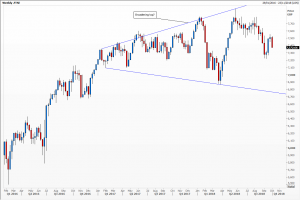Ambiguity: “When nothing is sure, everything is possible”
Said author Margaret Drabble who came to my school to give a talk years ago. The quote was used recently by Penelope Freeland, a teacher at another school of mine, who was writing about how uncertainty is a condition of life. ‘’Total certainty is, at best, an illusion. We’ll never know for sure what the other side is thinking…whether the decisions we make today are the best ones.’’
She continues: ‘’the speed of life increasingly demands that we make decisions in the absence of complete or definite information. Tolerance for ambiguity comes at the expense of clarity’’. Which set me thinking just how very often, when I’m looking at my charts, I’m wracked by doubt. Are we in a bull or bear trend? How far back should I go to be sure. One oscillator says up; the other says down. Is it a hammer or a hanging man candle when it’s lies at the mid-point of a range?
The standard answer is that the more indicators one has spotted that are pointing in the same direction, the more confident one can be; confluence, they call it. Yet, what if the rules of the game are subtly changing? That more business is being done off-exchange and over-the-counter so therefore recorded volumes are dwindling. Or when an industrial commodity is no longer used in the manufacturing process, hence a constant grind lower in its price. Or when alternative investments have captured the attention of the trading community forcing a shift in interest. Here I’m thinking of a reader email I received today suggesting I stop daily commentary on gold as it’s been superseded by crypto-currencies.
I know Elliott Wave postulates five waves up, three waves down, but how many waves can a broadening top contain? Or how much weight should one give to the effects of a tumbling exchange rate on the chart patterns of assets denominated in those currencies. No guesses as to which indices I’m thinking of today!
I certainly don’t have the answers to these and more. But I do know that approaching technical analysis with humility and fresh, unbiased eyes is a good start. Regular use and extended experience add to the mix. The flexibility to change tack when one’s probably got it wrong, essential.
Tags: Ambiguity, Choices, Decisions
The views and opinions expressed on the STA’s blog do not necessarily represent those of the Society of Technical Analysts (the “STA”), or of any officer, director or member of the STA. The STA makes no representations as to the accuracy, completeness, or reliability of any information on the blog or found by following any link on blog, and none of the STA, STA Administrative Services or any current or past executive board members are liable for any errors, omissions, or delays in this information or any losses, injuries, or damages arising from its display or use. None of the information on the STA’s blog constitutes investment advice.
Latest Posts
- How I Used Dow Theory to Strengthen My Market Convictions June 20, 2025
- The New Monetary Order: Russell Napier on Inflation, Debt, and Financial Repression June 12, 2025
- Why I Became (and remain) a Member of the STA May 29, 2025
- The Emotional Rollercoaster of Markets: Why Bubbles Repeat and How to Outsmart Them: Summary of Kim Cramer Larsson talk May 14, 2025
- Avoid Overusing Indicators: Streamline Your Trading Strategy May 7, 2025






















Latest Comments